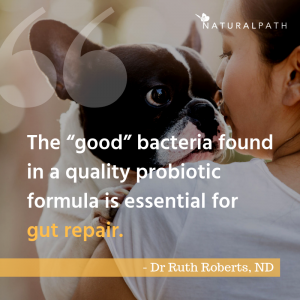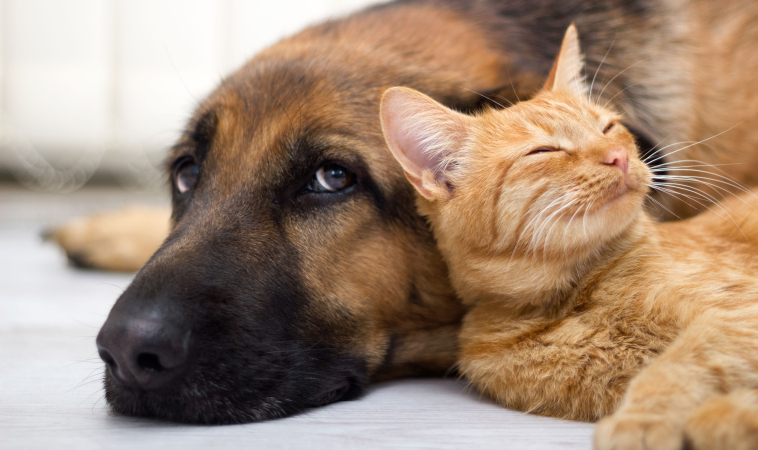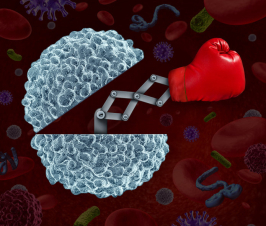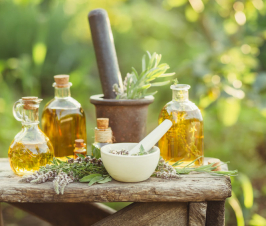Dr. Ruth Roberts, DVM, CVA, CVH, CVFT
If your dog or cat has ever had tummy troubles, you already know that it’s frustrating beyond all doubt – especially if you don’t know what’s causing it. Changing foods and introducing new medications frequently can run you ragged and make you feel like you’re going in circles.
The great news is that there’s a solution to this mess. It may take some more time and patience, but healing your pet’s gut is possible. By transitioning your pet to a customized, home cooked diet, and adding in a few supplements, even the trickiest GI cases can be solved. Create better gut health for your pet with just a few simple steps.
Create better gut health for your pet with just a few simple steps
 Start by working with your local vet to be sure illness or disease is not the cause for the GI upset you’re seeing. Some lab work may be necessary, but it’s worth it in the long run to make sure your pet is in overall good health.
Start by working with your local vet to be sure illness or disease is not the cause for the GI upset you’re seeing. Some lab work may be necessary, but it’s worth it in the long run to make sure your pet is in overall good health.
After ruling out illness, it’s time to consider allergy testing. Unbeknownst to their owners, many pets have food sensitivities or allergies. A Life Stress Scan can help you identify any food or environmental sources of inflammation or reaction. Once you know what you’re up against, the fight will be much easier.
If you aren’t able to pursue official testing, you can try to identify food triggers at home. By using The Original CrockPet Diet, and isolating each food group in the recipe, you can pinpoint whether certain foods are to blame for your pet’s GI upset.
Use one single protein, one vegetable, one brassica vegetable and a single starch (if you use one). In subsequent batches, switch ingredients one at a time, per each batch. It may take a little time before you’re able to nail down which food or foods are to blame, but don’t give up.
Stick with Home Cooking
One reason I love The Original CrockPet Diet so much, is that it gives me the opportunity to personalize a home made diet for each of my patients. And it’s easy for pet parents to do themselves. If your pup loves poultry, but has itchy skin or arthritis, you can choose to give them cooling turkey rather than chicken (food energetics play a huge role in this recipe). Even better, you don’t have to sacrifice her favorite foods – whether it’s duck or summer squash – because you can’t find a commercial food with those ingredients.
Home cooking also helps your pet avoid foods that they’re sensitive to, without the potential danger of contamination during factory production. Many store-bought pet foods contain trace amounts of unlisted ingredients, and even toxic substances. Making your pet’s food at home protects them from potentially hazardous ingredients.
Once you find a formula that works for your pet’s gut, stick to it. After their gut has some time to heal, try rotating in new proteins or ingredients, one at a time. Variety is important in your pet’s diet (for protein, especially), and will keep them from developing new food sensitivities and subsequent gut issues.
Probiotics Powerhouse
I can’t emphasize the power of these tiny guys enough! The “good” bacteria found in a quality probiotic formula are essential for gut repair. Maintaining a balance of good vs. bad bacteria in the gut will finally allow the lining of the stomach and intestines to begin healing. The healthy balance of flora in the gut is important for a pet’s gut health, but also for their overall health.
Both physical and mental well-being rely on healthy gut function (especially immune support). Keeping the balance of good bacteria now will help keep your pet strong and ready to fight off anything. So, whether your pet is healthy or struggles with chronic GI symptoms, a good probiotic will still benefit her the long run. After all, preventing imbalance and illness is easier than treating it.
Fueled by Fiber
All those vital probiotic flora are most helpful when they’re properly fed. Good bacteria need plenty of digestible fiber for fuel. Here, your home-cooked pet food ingredients are your strongest tool.
Easily digestible fiber comes in many forms for pets. Some of my top picks include barley, peas, apples or citrus. Offer some of these foods as a healthy treat for your pet, to add some tasty fiber and a tail wag to their daily regimen.
Be aware that foods very high in fiber can also cause gas or GI disruption when consumed in large amounts. So, take it easy and provide your pet with a good balance of different foods and ingredients.
Stay the Course
Revitalizing your pet’s diet (and subsequently, their gut health) can take some time. Any time you change a pet’s diet, you should always do so slowly and patiently. Each pet works on their own schedule, and some can take longer to acclimate to a new diet than others. This is especially true if they need extra time to heal.
If you find yourself becoming impatient with the time this transition takes, remember that there is no “quick fix” for good health. Even the best treatments need a little time to work their magic.
It’s never too soon to start thinking about your pet’s gut health, and how you can help their GI system stay healthy for life. After all, Your Pet’s Best Health Starts in the Bowl!


 Dr. Ruth Roberts, DVM, CVA, CVH, CVFT is a holistic integrative veterinarian, who has been healing pets for over 28 years. With extensive knowledge and training in holistic veterinary therapies, she uses a combination of diet therapy, Chinese herbs and other natural methods to help cats and dogs recover from illness and enjoy their healthiest, happiest lives. Dr Ruth provides remote consultation for pets, guiding pet parents through effective and gentle treatment for their furry friends.
Dr. Ruth Roberts, DVM, CVA, CVH, CVFT is a holistic integrative veterinarian, who has been healing pets for over 28 years. With extensive knowledge and training in holistic veterinary therapies, she uses a combination of diet therapy, Chinese herbs and other natural methods to help cats and dogs recover from illness and enjoy their healthiest, happiest lives. Dr Ruth provides remote consultation for pets, guiding pet parents through effective and gentle treatment for their furry friends.














